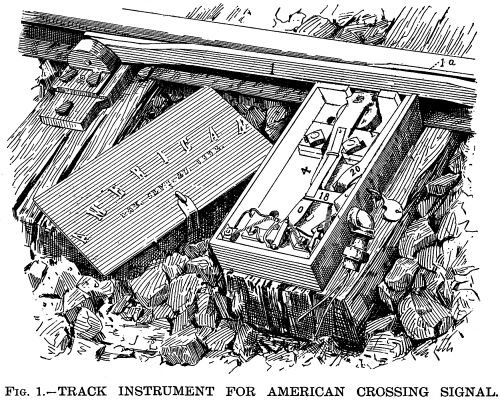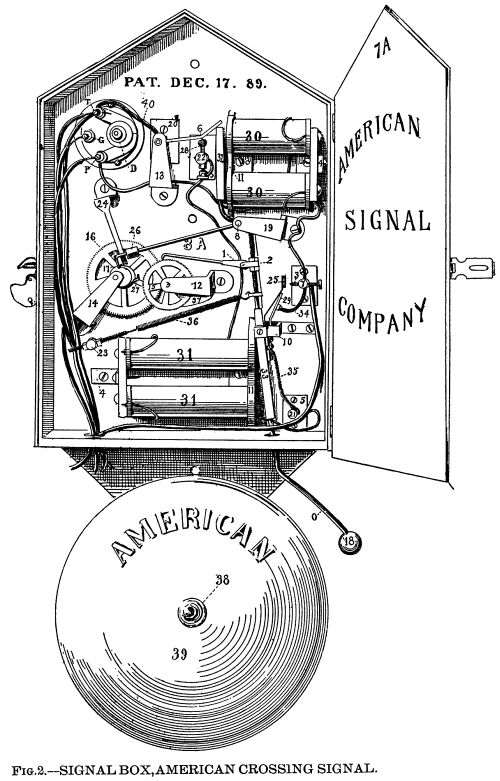THE AMERICAN CROSSING
SIGNAL.
Railway Engineering and Mechanics—June,
1894
As long as grade crossings exist a perfectly reliable and automatic
crossing signal is essential to safety. The American Signal Co.
of Baltimore, Md., are furnishing a signal which has stood the
test of five years of service, and is to be commended for its
simplicity and reliability. In the accompanying cuts we show its
essential features, Fig. 1 being the track instrument for single
track roads, and Fig. 2 the alarm box and bell.
 As will be
seen in Fig. 1, the single track instrument has two concussion
bars, 1 and 1a, shaped so that when a train is approaching a crossing
bar la is depressed thereby de pressing lever 20 which releases
latch 18 and causes it to pass under the end of a mercury tube
0. The second bar 1 is next depressed which acts upon lever 6,
tilting the mercury tube 0 and making an electric contact. After
the train has passed the crossing it arrives at the second instrument
(placed for traffic in the opposite direction) and then the bar
1 is first depressed, which causes latch 18 to pass over, instead
of under, mercury tube 0, and prevents the closing of circuit
and giving of alarm. As will be
seen in Fig. 1, the single track instrument has two concussion
bars, 1 and 1a, shaped so that when a train is approaching a crossing
bar la is depressed thereby de pressing lever 20 which releases
latch 18 and causes it to pass under the end of a mercury tube
0. The second bar 1 is next depressed which acts upon lever 6,
tilting the mercury tube 0 and making an electric contact. After
the train has passed the crossing it arrives at the second instrument
(placed for traffic in the opposite direction) and then the bar
1 is first depressed, which causes latch 18 to pass over, instead
of under, mercury tube 0, and prevents the closing of circuit
and giving of alarm.
The double track instrument has but one concussion bar, which
is depressed and acts upon lever 6 which tilts mercury tube 7
allowing mercury to pass to end of tube and make the contact.
When the circuit is thus closed at the track instrument, the
armature 32 (Fig. 2) is attached to the magnet 30. As the armature
32 moves, the detent hook 26 is raised out of the notch in the
drum 17 and held suspended by the spring 24 until it is released
by the trip pin 27, when it again falls on the drum 17. When the
armature 32 is attracted to the magnet 30, the hinged contact
plate 6 which rests on it, falls to the contact point 28, causing
the current from the battery to go to the magnet 31, operating
the bell and ratchet pawl 1. As long as the, detent hook 26 rests
on the drum 17 the armature 32 cannot fall back far enough to
break the contact between 6 and 28, consequently the bell must
ring until the detent wheel 16 has made an entire revolution,
when the hook will fall into a notch and the circuit be broken
and the bell will stop. Should it happen that a train teaches
the circuit-closer on one track when another train has nearly
reached the crossing on another track, the detent wheel 16 will
make a second revolution, causing the bell to ring just twice
as long as it would had there been but one train.
 The simplicity
of the construction is thus apparent, there being few working
parts and these are all well made of the best material. There
is practically nothing to get out of order, so that the bell can
be relied upon for effective service for a long term of years.
This freedom from frequent repairs, which seems to be necessary
in many devices of this character, is one of its strongest claims
for economy. It is not affected by the speed of trains, and is
adapted to roads having frequent and high speed train service,
and can be placed at such distance from the crossing as to give
warning to from one-half to three minutes before the arrival of
train. The track instrument can be placed on bridges or in the
centre of streets, for its dimensions being 15 inches long, 8
inches wide and 3 inches deep, it offers no obstruction to vehicles
in the latter position. Its motive power is eight one-gallon jars
of the Edison-Lelande battery. This battery will withstand a temperature
of 50 degrees below zero, which places it beyond the reach of
probable climatic changes. The simplicity
of the construction is thus apparent, there being few working
parts and these are all well made of the best material. There
is practically nothing to get out of order, so that the bell can
be relied upon for effective service for a long term of years.
This freedom from frequent repairs, which seems to be necessary
in many devices of this character, is one of its strongest claims
for economy. It is not affected by the speed of trains, and is
adapted to roads having frequent and high speed train service,
and can be placed at such distance from the crossing as to give
warning to from one-half to three minutes before the arrival of
train. The track instrument can be placed on bridges or in the
centre of streets, for its dimensions being 15 inches long, 8
inches wide and 3 inches deep, it offers no obstruction to vehicles
in the latter position. Its motive power is eight one-gallon jars
of the Edison-Lelande battery. This battery will withstand a temperature
of 50 degrees below zero, which places it beyond the reach of
probable climatic changes.
The following are some of the special features of this signal:
It will withstand a temperature of 50 degrees below zero; it is
not affected by the speed of trains: the crossing is protected
whether the train is a fast or slow one, as the detent wheel makes
a second revolution when the train is a slow one, taking fifteen
seconds or more to pass over the track instrument, thus protecting
it twice as long for a slow as for a fast train; the track instrument
can be placed on bridges, trestles or in the centre of streets,
without fear of obstruction or breakage, and it is not continually
out of repair; there are no "cut outs" necessary on
the track as the cutting out is done automatically in the alarm
apparatus; there are no timbers necessary, the track instrument
being placed on the end of a sound cross-tie; the track instrument
is not affected by snow nor is the apparatus "burned out"
by lightning.
The company furnishes the signal complete, including wire, insulators
and brackets, and sends a man to erect them. The works are at
Thurmont, Md., (formerly Mechanicstown) where the company is equipped
to turn them out in large numbers. During the five years in which
the signal has been used the company has received many strong
testimonials of its value.
Stories Page | Contents Page
|







